#Cornish lore
Explore tagged Tumblr posts
Text
Vintage Foster's Pottery Cornish Pixie & wood log design cart with hand applied coloured drip glazes, handmade at there original factory at West Tolgus in Redruth Cornwall UK.
#cornish pottery#cornish pixies#wagon carts#buy studio pottery#fosters pottery#redruth#cornwall#fantasy#cornish folk lore#clay#ceramic art
0 notes
Text
Book Review: The Witch's Art of Incantation, 2nd ed. by Roger J. Horne

10/10, I'd buy again for what it is: but you should know what it is before you buy it
This is a review of the second edition, which is about 100 pages longer than the original and contains 55 additional incantations.
What's it about?
This is a book of translated and edited historical and folk incantations to be used in syncretic folk witchcraft or any form of witchcraft. These incantations are grouped into 9 categories:
Seeking the Old Ones
Calling to the Green World
Love and Spurned Love
Coinage and Prosperity
Curses and Maledictions
Spirit Flight and Second Sight
Blessings and Benedictions
Heretical Psalmistry
Miscellaneous latinate charms
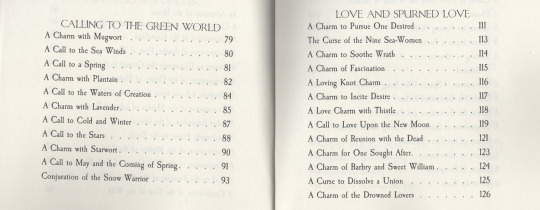
Besides a brief introduction, the book is just incantations.
It's not a spellbook. It doesn't tell you to collect candles or herbs, or what day of the week to work them on, or the moon phase, or whatever. Just as it says on the tin, it's a book of incantations.
However, Horne does have a very handy section at the beginning called Approaches to the Art of Incantation.
Here he describes methods and techniques to help empower incantations (I recommend not skipping it), a framework for understanding the power of words, and folk magic actions that may be combined with incantations, such as the burning of candles with pins stuck in, or speaking over poppets.
If you've skipped Folk Witchcraft, definitely check out this section.
(As Horne explains in the introduction, the first ed. of this book was a companion book to his other text, Folk Witchcraft. Apparently, Folk Witchcraft provided a great deal of context and lore surrounding the use of the incantations themselves.
The second ed. has been developed into a standalone text, but Horne still recommends looking to Folk Witchcraft if you want more context.)
Where do these incantations come from?
Horne makes it clear that he primarily sourced incantations from Europe and America (primarily Appalachia) not because they're particularly better in any way, but because these are the areas his ancestors and practice stem from. He makes an outspoken statement against any perceived Eurocentric authority, and warns people to not take his area of focus to mean there is more power within those cultures than within others.
That being given, these incantations are sourced historically from at least the first century onward, from a wide variety of sources, including Greco-Roman, Irish, Scottish, Cornish, Welsh, French, German, Appalachian, Icelandic, and more.
When possible, Horne notes where the incantation originated from, and in what manner he edited it.
All of these incantations have been edited for use by the modern reader; they are Horne's original adaptations. This is not a historical reference.
An example?
To give you an idea of the contents, this is one of the shorter incantations in the book, "A Call to Fire."
A Call to Fire Fire untamed, lustrous, and bright, power behind the sun, moon and every star. Aetherial fire, source of life, most splendid flower, heat-bringer, light-bringer, hear me, radiant fire. [Origin: 3 BC - 1 AD. Greco-Roman. Adapted and rearranged with poetic license after The Hymns of Orpheus. pg. 100.]
This incantation may be used to charm offering candles, to consecrate sacred fires, to call forth salamanders or fire elementals, to honor a god or spirit of fire, and so forth - the application is up to you.
Is the variety solid? Are they versatile enough for use even if you don't consider yourself to be a folk witch?
A big reason I recommend this book so highly isn't just because it's handy for me, but because I think it is very versatile.
The variety of what's presented is exceptional; there are charms to hail the seasons and the moons, the Old Ones and plant allies, to cure grief and wrath, to call a lover, to steal wealth, to conjure all varieties of helpful spirits, to reveal a thief, to hag-ride, to skin-change, to induce second-sight, to charm your cards for better readings, and I could go on and on.
In addition, because Horne sources everything where he can, it's a wealth to look not only at his adaptations but compare the charms to the historical originals, and thereby gain inspiration for developing your own incantations.
The best part for me is that they're all usable. It's not a spellbook where you can't get some ingredients so you can't use some spells. They're incantations that you pair with whatever spell elements you want to include, including just using them on their own.
But are they sexy? Will I feel like I'm living deliciously?
Yes. You will feel like you are living deliciously. You will feel like ye olde wytche who feeds blood and honey to their familiar, and steals the potency of men at night as you roam in your second skin; you will believe you may only be harmed with a silver bullet when you take the form of a hare to rob milk from cows.
Real quick, what's up with those 'heretical psalms' and latinate charms?
The last (and smallest) portion of the book more heavily leans into syncreticism. Horne's attitude in the book is that folk witchcraft is by practicality and oftentimes necessity a syncretic one, and that witches use what's on hand in order to get the job done. He references the importance of the influence of the Church on modern cunning traditions, including both the adoption of psalms and also of latinate language.
Twenty-three psalms are printed in the book along with recommended magical uses, along with a list of the magical uses of psalms (which you'd have to look up yourself).
Finally, Horne has a fifteen incantations in Latin. Or, latinate, as he keeps clarifying. He hasn't taken charms and translated them into Latin, rather he's edited historical folk charms that were recited in liturgical Latin by the people who used them - again emphasizing syncreticism in folk magic.
If you're not into Christian syncreticism, I doubt this section would be of use to you. This section constitutes 80 total pages out of 319, or about a quarter of the book. Personally I'd still get it for the more pagan incantations even if I didn't want the more syncretic ones, but it's certainly not to everyone's tastes.
(Be advised that there is a lot of Scottish folk magic in this book, plenty of which calls on Mary as divine authority. Obviously you can change the incantations as you please, but if you're allergic to these things, be aware they are peppered throughout the text.)
Chicken, who would you personally recommend this book to?
I would recommend this book to a practitioner who is:
Ready to start seriously investing in their personal repertoire of spells
Confident enough to experiment with spellcrafting
Sick and tired of spellbooks that recommend inaccessible ingredients, and just want building blocks to make their own full-format spells
Wanting a resource that helps with getting practical magic done within their current paradigm, without having to adopt a lot of new ritual aspects or theories
Looking for inspiration to expand their current practice without having to restart their practice
Looking for resources on Christian or heretical witchcraft
Anyone seeking resources on the power of words in practical sorcery
I'm a pagan, not a witch, and I love hymns and incantations. Would I like it?
To be honest, I doubt it.
Yes, the book starts with incantations to the Old Ones, who are ostensibly gods; but anyone with an eye to see can tell that the incantations all either relate to the Devil or the Queen of Witches. Also, one for Fenris ("darkling wolf") and one for the Sun.
Like 5 of the incantations may clearly be associated with Greek gods, but those gods are not named and the association appears to be selected based on their relevance to witchcraft.
A vast majority of all incantations in the book are related to spellwork and conjuring nature spirits. These incantations were designed for use in magic, which includes calling spirits and compelling action; not so much veneration or worship.
Readability and Accessibility
The physical quality of the book is disappointing. And that's not the author's fault and has no bearing on the actual contents, but right out of the box I was afraid the poor thing was going to fall apart. However it was cheap as hell so I have nothing to complain about, this thing was like $15 for a paperback. It has the quality you would expect from such a cheap purchase.
The text is sort of an artsy one? It's a serif font that's not too out there, but it's smaller than I was expecting, and my eyes don't love it. You will have to find your reading glasses for this one. All his books I bought are published in this typeface so I assume it's a choice.
Horne loves big paragraphs and long sentences. I find his writing style to be clear and easy to follow, but it's not a lower grade reading level. You may expect a maximum of two paragraphs per page in the prose portions.
The incantations themselves are broken up into much more manageable parts, always containing no more than 2 lines per paragraph break.
I believe Horne did this on purpose to compel the reader to find their own cadence in the incantations. But, it has the added effect of contributing to readability. The way each incantation is split up makes it very easy to follow and not lose your place.
6/10 for physical manufacture; I really wish the typeface was less artsy and more standard, but I could still read it through, especially once I got used to it.
#book review#witchblr#witch community#the witch's art of incantation#roger j horne#long#long text#witchcraft#witch books#windvexer book review
150 notes
·
View notes
Text
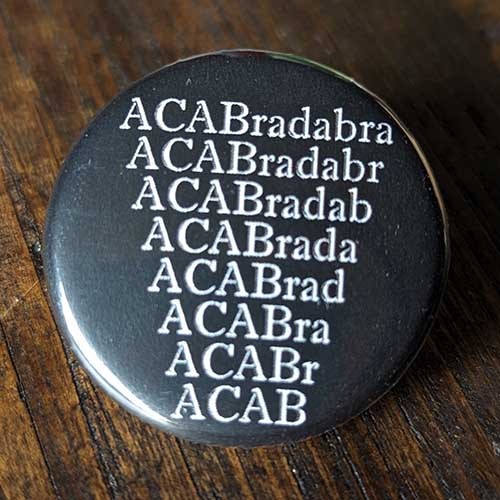
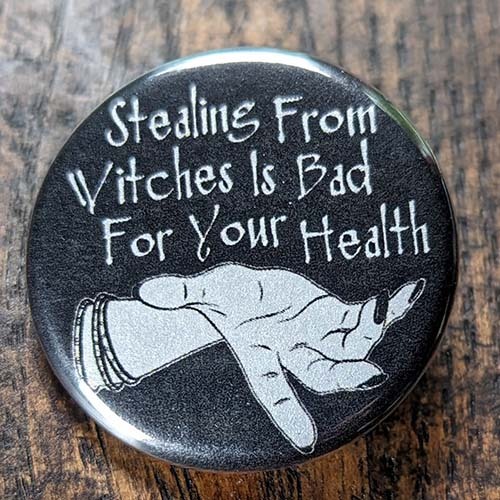
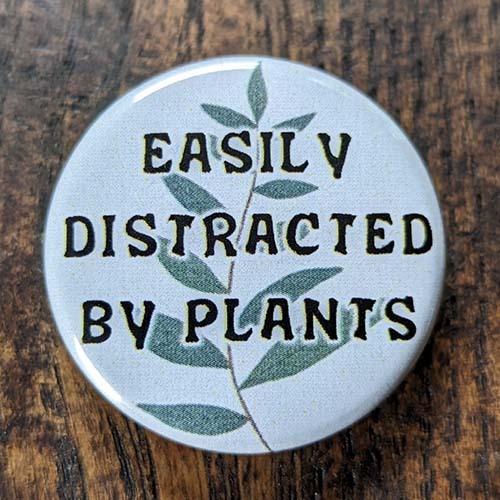

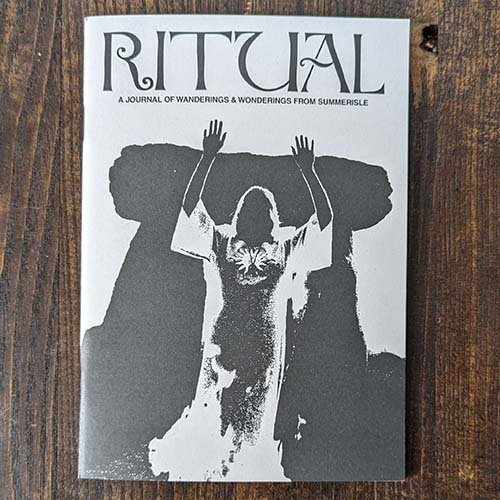
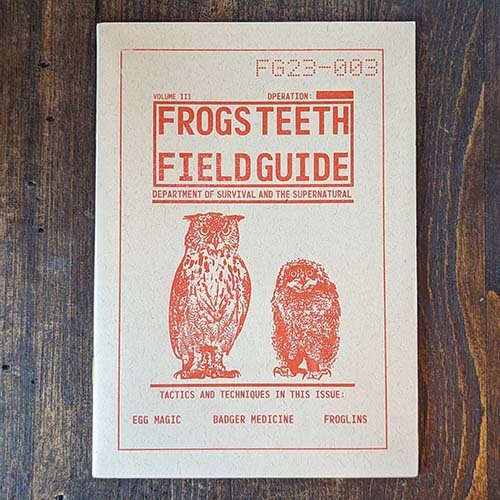
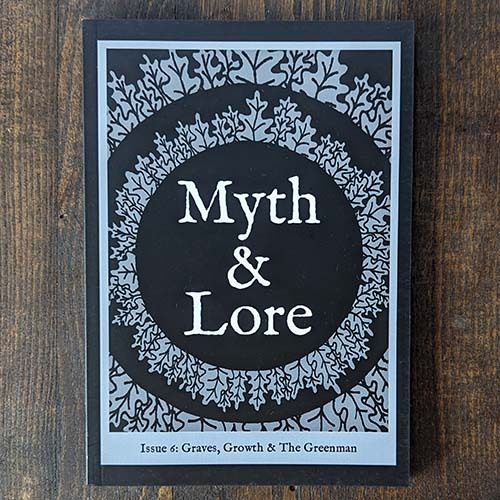

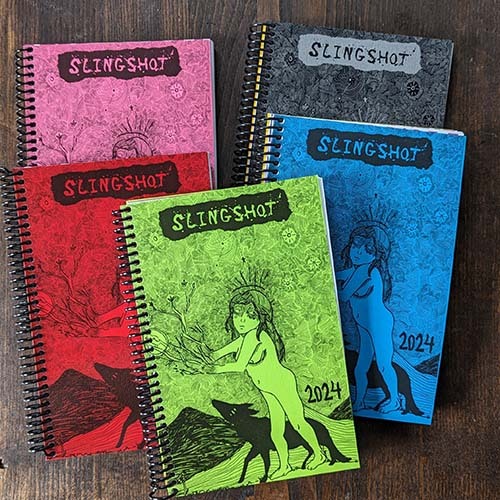

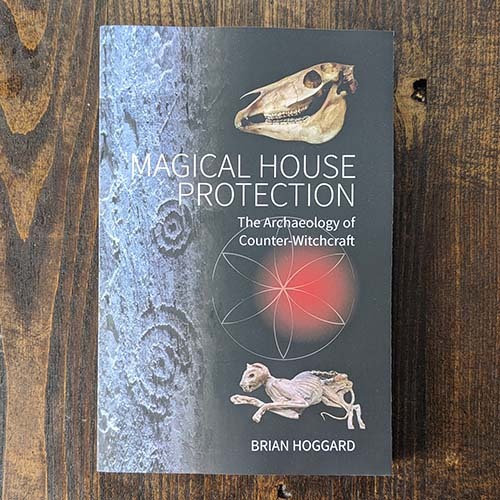


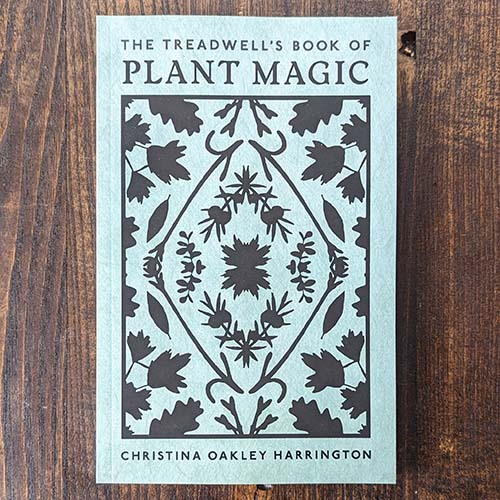
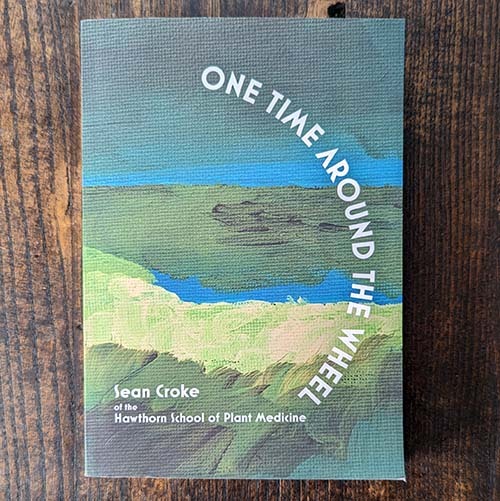

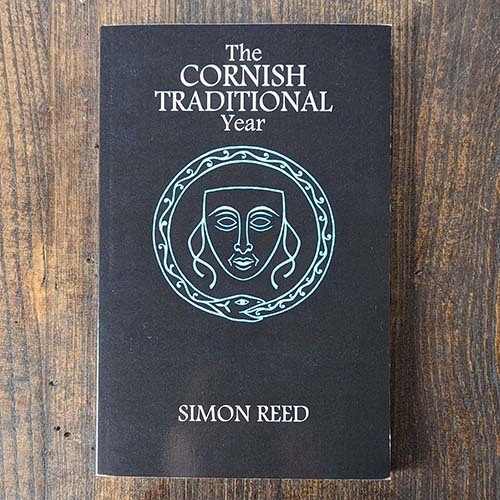
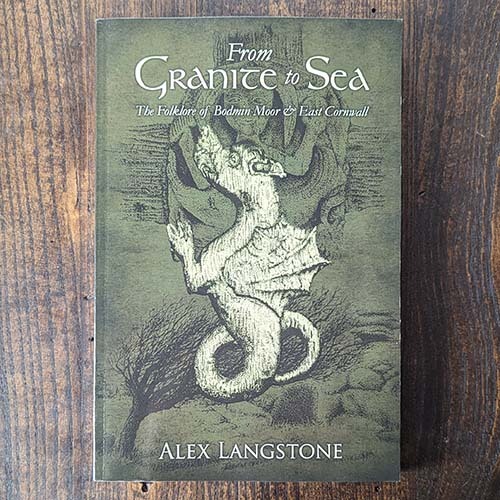
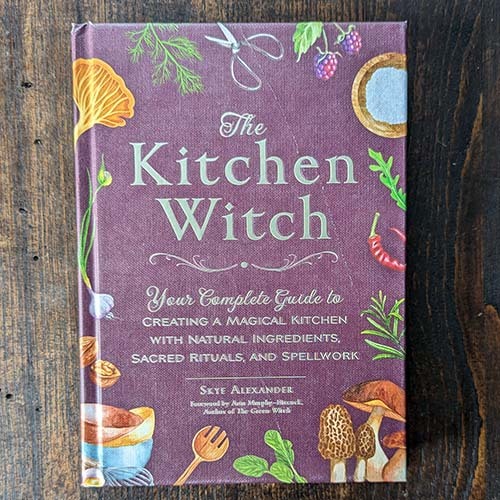

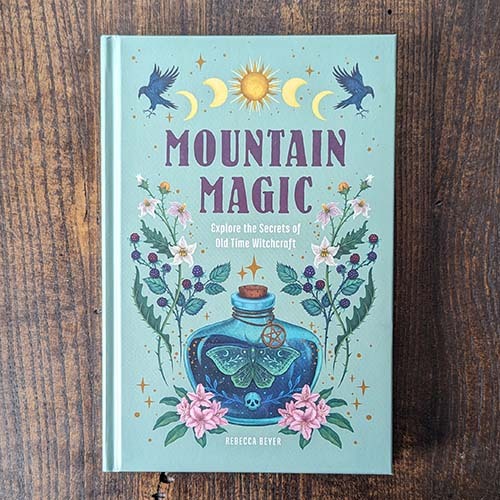
It's been a busy vending season! I finally got a chance to update the website with these new buttons, zines, books, and organizers!
Portland Button Works & Spiral House Shop September 22, 2023! - New in Stock for Autumn!
BUTTONS
ACABradabra
Stealing From Witches Is Bad For Your Health
Easily Distracted by Plants
Easily Distracted by Cats
ZINES
Ritual (from the folks at Weird Walk comes a fanzine about The Wicker Man)
Frogs Teeth Field Guide Issues 1, 2, 3
Myth & Lore Issues 1, 2, 3, 4, 5, & 6
SLINGSHOT ORGANIZERS
Small pocket sized
Small spiral bound
Large spiral bound
BOOKS
Sigil Magic: For Writers and Other Creatives by T. Throrn Coyle
Magical House Protection : The Archeology of Counter-Witchcraft by Brian Hoggard
Witch Bottles: History, Culture. Magic by Daniel Harms
Occult Botany: Sédir's Concise Guide to Magical Plants by Paul Sédir
The Treadwell's Book of Plant Magic by Christina Oakley Harrington
One Time Around The Wheel by Same Croke
Black Dog Folklore by Mark Normal
The Cornish Traditional Year by Simon Reed
From Granite to Sea: The Folklore of Bodmin Moor and East Cornwall by Alex Langstone
The Kitchen Witch: Your Complete Guide to Creating a Magical Kitchen with Natural Ingredients, Sacred Rituals, and Spellwork
In the Shadows of 13 Moons: Magical Empowerment through the Dar Lunar Mysteries by Kimberly Sherman-Cook
Mountain Magic: Explore the Secrets of Old Time Witchcraft by Rebecca Beyer
#ACAB#witch shop#witch store#witchblr#witchcraft*#witch books#magic books#green witchcraft#pagan#slingshot organizers#traditional witchcraft#folk magic#treadwells#plant magic#sigils#sigil magic#witch bottles#magical protection#black dogs#shadow work#conish magic#cornish witchcraft#kitchen witch#gemma gary#troy books#wickerman#wicker man#myth & lore#myth and lore#witchy zines
448 notes
·
View notes
Text
Nevarran Names
Whenever I write for a setting I like to have a few lore-friendly names handy for OCs or tossing out places in dialogue. I noticed that Nevarran names seem to come in a few flavors, the two major ones being Cornish (of all things) and Germanic. The pivot to more German names seems to be recent, but it's created an interesting class divide. So your more place-names and those of the aristocracy are Brittonic, especially Cornish. The first characters we hear of from Nevarra are upper class, so that tracks. Names like: -Pentaghast, with a lot of surnames in Cornwall having the 'Pen' prefix, meaning top, end, or head. Lord Penrick Karn is another example. -Van Markham looks to be a play on the Cornish surname 'Morkham' -Cumber/land is Brittonic and from the same language root as 'Cymru' and 'Cumbria. -Perendale, possibly derived from St. Peren, the patron saint of Cornwall. I think with Nevarra becoming more of a player in the DA lore, the devs needed more distinction between other British-flavored states in the setting and went for German ones. Because in the short stories/comics you start seeing names like: -Felhausen -Hezenkoss -Reinhardt -Volkarin These tend to be names of commoners and lower gentry (makes sense, gotta fill in your setting). But from a Holmesian perspective it creates an established old gentry with one linguisitic origin and a commoner population / new gentry of another. Kinda how after the Norman conquest you have 'oops all French' in English upper class surnames. The Tannhausens are an outlier, but they first pop up in Veilguard. The codex in Veilguard also mentions that 'proper Nevarran names' have three syllables, I can't quote it off the top of my head, though. TL;DR: Originally Nevarra was Cornish but then it got important or writer changes and it got more German. For flavor in fanfic, use three-syllable names derived from Cornish or Cumbrian for old money and German for normies. I have no idea where Anaxas came from and I don't wanna look it up.
#I am not a linguist I just have a background in the humanities#Dragon Age#Nevarra#Mourn Watch#Thedas#meta#It starts with you having the hots for fictional old men and ends with you looking at Brittonic prefixes.
16 notes
·
View notes
Note
hello,
this may sound like a silly question, but is it possible for someone who is not Irish, scottish, or British to be contacted by the Fae?
thank you!
Hello there.
This isn't a silly question, but it's one I will have to expound on a bit, as opposed to just giving a yes or no answer. I'll also preface this by saying that my personal beliefs will likely be contentious to some, and I encourage readers to take what they find useful and leave the rest if it conflicts with their own paradigm. Most of this comes from a mixture of personal gnosis and theory, and I am not attempting to assert authority on the subject or claim academic accuracy, so please keep that in mind.
To put it very simply, I believe that the Fae are present in every region of the world, and I have highly syncretic beliefs about the nature of the Fae and other spirits in general. For me, the folkloric specifics come down to cultural lenses and the ways that long-term worship and perception shape the expectations and manifestations of the Gloaming Folk. So, no, I don't think one has to be Gaelic or Brythonic in order to cultivate a relationship with the Fae.
For instance, when looking at the Faerie Faith, many people think primarily—if not only—of the insular Celts. The Fair Folk of the English; the Aos Sidhe of the Irish; the Daoine Sìth of the Scottish; the Sheeaghan of the Manx; the Twlwyth Teg of the Welsh; the Spyrysyon of the Cornish; and the Korrigan of the Breton. But in the larger context of Germanic and Scandinavian folklore, there is copious evidence of entities that are undeniably similar to the Fae as they are understood in the Insular Celtic Isles. In fact, the Germanic word Elf is so closely aligned with the term Faery that many people don't even realize or think about the fact that they derive from different cultures. That being said, the Germanic/Scandinavian "lens" of Faerie Lore is probably the other best known by the wider public.
Likewise, there are multiple beings that show up in Slavic mythology and folklore—such as the Vila, the Rusalke, or the Vodyanoy—which are pretty readily accepted as Faeries. I don't know of an overarching term that would necessarily be equivalent, but the folkloric link is still there.
Now, moving into a more controversial aspect of my beliefs, I also happen to think of Angels, Demons, and Djinn in terms of Gloaming Spirits. While I readily admit that millenia of regionally specific belief and veneration form unique "identies" that Spirits of a given culture may align more closely with, I believe that they are all part of one larger "family" of beings who have been interacting with humanity for many thousands of years. I realize that this will likely be considered an egregious oversimplication for some, or possibly even an erasure of the individuality these cultures possess; but for me, the things that make a tradition sacred and unique are not invalidated or snuffed out by by the fact that other cultures may find recognition in them. So, while I do think beings like Angels, Demons, and Djinn are inexorably interrelated, I also fully accept that they are unique and culturally specific. And frankly, I find it hard to believe that others who have engaged in intensive personal gnosis haven't come across similar threads of paradoxical interconnection.
Beyond these, though, I've also pinpointed other entities over the years that I think represent reasonable approximations of the Fae. These include things like:
The Peris of Persian Mythology (Beautiful aerial spirits sometimes known to work with humans called Peri-Kahn, who gained skills and abilities from the relationship. They are generally described as humanoid figures with beautiful wings, who are known for their michevious behavior, though at least one work references them as divine beings denied entry into paradise until such a times as they have atoned—a folkloric motif some will recognize in connection to certain folk-beliefs regarding the Angels and the Fae.)
The Yakshas of Hinduism, Buddhism, and Jainism (Spirits of nature often connected with water, fertility, plants, treasures, and the wilderness. While some are considered benign or benevolent, others are considered more mischevious or sinister, though most are considered capricious. Sometimes associated with ecological forces, and at other times, with the spirits of the dead. )
The Yōkai of Shintō (A diverse array of spirits—often explicitly equivacated with fairies, demons, and/or sprites—known to interact with humans in both benevolent and malevolent capacities. While many of these spirits are quite singular in their uniqueness, others are more recognizable within a broader archetypal folkloric context—such as the Zashiki-warashi, which are described as diminutive domestic sprites known for both their ability to bestow good fortune, and their tendency to perform mischevious pranks.)
The Korpokkur of Ainu Mythology (A race of little folk, associated with the Butterbur plant, who were said to leave gifts under cover of night—as they did not like being seen. They were believed to be the original inhabitants of Japan before the Ainu—which also echoes aspects of Celtic Faerie Lore.)
The Aziza of Dahomean Mythology (A race of supernatural little folk who are said to live in the Wilds—often beneath Anthills or within silk-cotton trees— and use their magic to help humans, as well as providing people with practical knowledge and spiritual wisdom.)
The Yumboes of Wolof Mythology (Spirits of the dead described as little folk with pearly white skin and silver hair who lived beneath hills and come out to dance beneath the Moonlight. They are known to hold great feasts, which humans are sometimes invited to.)
The Hellenic Nymphs, Sirens, and Kobaloi (As many know, Nymphs are animistic spirits of nature, considered beautiful, and known to interact with humans. Likewise, most will have heard of Sirens as beautiful, seductive, and dangerous spirits of the water who are known to entice and drown men. The Kobaloi, in turn, are described as a mischievous race of small goblin-like folk who are fond of playing tricks on human kind.)
The Basque Iratxoak, Laminak, and Mairuak (An Iraxto is a type of domestic Imp or Goblin known to help with human labors in the night, if properly propitiated. A Lamina, on the other hand, is a Water Maiden described similarly to Sirens or Nereids. They are generally understood to have webbed duck feet and long beautiful hair, which they are fond of combing by the waterside. They are known for both their tendency to offer aid to those who show them respect and propitiation, and their tendency to seduce and ensnare men. Some traditions speak of male giants called Mairuak, who are closely associated with Laminak, and are linked by some with the construction of megalithic structures.)
The Duende of Iberian mythology (A term quite similar to 'Faery' in its usage, which encompasses a diverse array of spiritual entities who are generally said to appear as humanoid, though frequently capable of shapeshifting. They are often associated with nature and are known for their involvement with humans—be it helpful, romantic, michevious, or vicious. They include goblin-esque folk known as Trasgu, Water Maidens known as Xana or Anjana, and supernatural beings called Mouros who take refuge beneath the earth and rarely emerge near sites like barrows. The most common conception of a Duende, however, describes them as a mischevious sort of domestic imp or goblin known for their dealings with the human world. )
The Aztec Chaneque (A sprite-like race of little folk who are associated with Elemental forces and are often conceived as guardians of nature. These beings were once propotiated by the Nàhuatl peoples in exchange for protection from blight, intruders, and evil forces. However, they could also inflict harm, and they were known to sometimes kidnap humans and take them to their home in the Underworld of of Mictlàn to be seduced. On an interesting sidenote, one folk-method of protecting against them when traveling in the forest was for a person to turn their clothing inside out—a charm many will recognize from Celtic Faerie Folklore.)
The Mayan Aluxo'ob (Spirits recognized in the mythological traditions of certain Maya peoples, who are generally associated with particular features of nature. They are described as small and humanoid, and they usually remain invisible, though they can assume physical form for the sake of interacting with humans. Sometimes, wandering Aluxo'ob are said to ask for offerings from farmers or travelers and may respond with wrath if refused. If its conditions are respectfully met, however, it is said that an Alux will provide protection, luck, and aid. In fact, some traditions hold that a farmer can erect a specialized form of Spirit House in order to welcome in an Alux that will aid them for a contracted period of time with tending crops, summoning favorable weather, and guarding property. What's more, there exist naming taboos that reflect themes of Celtic Faerie Lore.)
The Guarani Pombero (A spirit particularly important in Paraguay, though it appears in multiple mythological traditions from the surrounding area. The Pombero is generally conceived as a small hairy man who lives in forested areas and abandoned sites, and is known to cause mischief for humans. It is said that the Pombero can become invisible, change shape, and perfectly mimick the sounds of the wild. Usually, he is considered harmless, if mischevious—known for antics like food theft, the loosing of cattle, and the scattering of household objects. Though, he is also known also known to occasionally abduct and/or impregnate women, resulting in the births of hairy children. The Pombero is capable of being appeased, however, through offerings such as cigars, liquor, and honey. It is even said that, if these propitiations are observed consistently for long enough, the Pombero will take a liking to a person or persons and provide protection for their home and posessions, as well as leaving gifts of their own in return.)
The Tupi-Guarani Curupira (A spirit described in the folklore of Paraguay, Amazonia, Brasil, and Argentina as a little man with bright red hair and feet turned backwards, which it uses to obfuscate the trajectory of its footprints. They are said to live in the wild, and will prey on hunters who take more than they need, or who harm animals while they care for their Offspring. They are also said to ocassionally abduct and/or impregnate women, resulting in strange or unexplained births.)
The Iroquois Jogah (A race of magical little folk spoken of in Iroquois lore. They are said to be largely invisible, and an array of phenomena are associated with them, such as mysterious drumming noises, rings of bare earth, disembodied lights, and "bowls" found in stones. Offerings such as tobacco and fingernail parings could be left within these stone bowls, as propitiation to the Jogah. They are fond of mischief and games, though they can also be dangerous if disrespected. It is said, for example, that they will cause illness in homes constructed upon sites that they favor. The Jogah are also known for the variety of sub-groups into which they can be divided, generally associated with particular aspects or features of the natural world.)
& the Māori Patupaiarehe (Beings described in Māori mythology as a pale folk with red or golden hair. They are said to live in the mountains, hills, and deep forests in communities unseen by human eyes. They are known to influence the mist and clouds, to play music sweeter than that of any human hand, and were said to sometimes act with hostility towards humans who encroach or intrude upon their land. Despite this, however, most traditions state that Māori are able to converse with them at times.)
These are only a selection of traditional beliefs, though there are many more I won't attempt to list, and who knows how many more I've never heard. These are merely ones that have particularly caught my notice over time, and which seemed worth mentioning here. However, I am far from an anthropological expert, and I encourage others to ammend, contextualize, and add onto this information as they see fit—especially if they come from a culture I reference here. My goal is not to imply that all of these traditions are somehow directly connected to the Anglo-Celtic traditions, or that Anglo-Celtic mythology should be the cornerstone by which all folklore is considered; it's just the cultural background I have the most personal connection to/understanding of, and so I aim to speak mainly from a place of my own experience (though, I am actually half Paraguayan as well.)
So, in conclusion, while I do think that one's own cultural and regional context generally plays an important role in how one is likely to encounter the Gloaming Folk, I believe that people from virtually every culture have the capacity for working with them. I think that, when attempting to approach the Fae, it's a good idea for one to come at it from the perspective of their own heritage and regional lore, but at the same time, one can't always help the way spirits end up cultivating relationships with them (and, honestly, I think it is better for one to wait for the Fae to approach them whenever possible.)
#fae#fair folk#gloaming folk#gloaming#otherworld#faerie folk#faerie faith#good neighbors#pagan syncretism#syncretism#faerie lore#faerie folklore#anonymous#ask
218 notes
·
View notes
Text

THANK YOU GUYS . Cringe culture is so dead but the demons get to me sometimes i get scared 😢
OKAY. Warrior cats au Anyone h ave name suggestions bc since it alters from WCs world building a bit i dont know if i should use the name. I am breaking so many wc rules here and idc
Okay so here, each clan is a lot bigger than the ones in the books. Like a whole city population with a lot of forest ground.
Mr oz (dont have a name for him) Is a warrior whos been around for a good while. He mentored both hannah, a somali cat (NAME REC PLEASE) and beau, Nightpaw but maybe his warrior name becomes Nightcatcher, maybe also a black Cornish Rex? hed also have blue eyes and hannah would have yellow.
Lunia was a sort of leader-medicine cat thing, new role i came up with , being really connected with starclan or stuff. dreamclan.? Not the exact leader, Abraham is, but is kinda moreso the spiritual leader and despite not fighting TOO MUCH everyone holds her in high respect across all clans
Migo wasnt an apprentince really but just a helper for her, maybe she can be a little mouse or something that lunia conjured/tamed with magic (yes magic will exist here because Im not restricting myself to wc rules IM BEING SILLY AND HAVING FUN) But because of her duties she didnt have time to hang out like they used to before lunia got into her role. Migo wants to remove her magic so she can just stay with her forever as a normal medicine cat and not have to go out and risk her single life in the most dangerous battles. Because she has magic shes really strong but also it makes her a huge target for cats against the clans, if she dies then it could risk the entire multiple clans relationship since they no longer have a common leader
Migos attempt at stealing her magic kindaa work out bc she has really fucked up magic powers now that require sacrifices to work or something❤️, perhaps all the power is in a special item... like maybe a bone/tooth from lunia on a collar , but in their final battle Lunia seals her SOMEWHERE and she disappears in the process. Lunia wanted to forgive Migo and go back so she never told anyone that the Nightmare king and her were the same person, she only said that something captured the little mouse.
So the Nightmare King is a sort of rodent/canine/monster thing trapped somewhere in the dark forest or something (idk i never read the arcs that focus on the dark forest and i dont plan to!this is my au i get to make my own logic no one correct me okay !!)
The loss of Lunia hit mr ozs team hard (hannah and beau were already warriors by this point) and they go try to destory a remnant of the nightmare kings weapon or something (since lunias tooth would be the hourglass equivalent. mr oz has it hidden somewhere because he doesnt trust the clans leader with it) Oh also mr oz turned down an offer to be deputy of all the clans .
Um more world building. because im coming up with stuff as i write this post. Theres like a main head leader for all the clans(branches) which is Royce, its just the deputy-leader system but it applies to all clans instead of just one.i guess
ALSO !! Astrid is Royces apprentince, its rare for the main leader to be a mentor so it means royce sees a lot of potential in her. i think she built her own little wheel thing to get around easier because she still wants to be a warrior cat / be able to participate in battles. Royce sees her as 'the next Lunia' and astrid isnt totalllyyyy on board with that but still she doesnt want to miss the chance to prove herself
OH ALSO ! Hannah lore.. I think she was a barn cat before Nightpawfound her one day when he was sneaking out of camp. They both hit it off and become really good friends and nightpaw wants to invite her to the clan and hannah agrees because she wants to be with him and it seems cool to her. Nightpaw confesses to oz about meeting her and while hes mad, he agrees to mentor her because no one else wants to mentor a random barn cat
Okay so then after nightcatcher and the others go to the gnorfs to try and destroy the nightmare kings weapon (the gnorfs can be beavers....) Nightcatcher gets a bit corrupted and over time it corrupts him fullly, it. makes him bitter and hateful. He tries to stay through it but a bit after hannah getes pregnant he leaves her and then the entire clans in general, he becomes a rouge and he wanders into the dark forest because he feels the nightmare king calling him from there. mr oz is really upset with it and checks in constantly with hannah to make sure shes doing alright and to be able to comfort each other.. Mr oz never had a mate so he saw them both as his own children kind of
one day hannah just cant take it anymore and she goes out by herself to try and find nightcatcher and they eventually come across eachother but she sees how he got corrupted and he fights her to go back, but doesnt touch her physically because he doesnt want to hurt her he just wants her to get away from him and the path he chose
hannah runs off but before going back to the clan area she gets found by some humans and they take her in and care for her. Shes kinda trapped there now but she tries to make the most of it there
She gives birth to zoey and theyre really close but then hannah dies due to illness around the time zoey is old enough to be an apprentince. Hannah never told her about the clans and all that but occasionally some warrior cats came to the farm theyre on to nab some herbs and stuff so theyve encountered them.
then one day the night hunter comes to where her and her owners are and maybe he attacks them or something, taking quite a bit of the livestock there. MAYBE Hm.. Okay so then zoey tries fighting him off and it doesnt go to well for the night hunter because he realizes thats his child and he doesnt want to hurt her and then he merges with the shadows and leaves quickly when the humans come running out. NOW EITHER zoey is upset that he killed a lot of the livestock and just wants to go out and do something else so she becomes a rouge before getting adopted into a clan, OR orrr her owners see the claw marks on the livestock and the blood on zoey and assume shes the one who attacked them and that shes too feral and agressive to be a pet for them so they throw her out </3 Forcing her to have to go out and hunt for herself. Eventually she saves the main kids while theyre. just barely apprentice age becase they snuck out to save cooper from something and since they were still kits they coudlnt defend themselves all too well so zoey saves them yahhh OKAY. Thats enough for this post i think/ OH BUT ALSO YEAh zoey wants revenge on the night hunter for taking away the only sembelance of family she had left yipeeee
#this was originally a reblog but its just to big for that now i need everyone to see this#lego dreamzzz#dreamzzz#i spent two hours typing this you better enjoy#dream cats au
7 notes
·
View notes
Text
The Devil's Foot pt 1
Gonna go ahead and assume that no actual devil's make an appearance in this one. So... maybe a location? Maybe a statue or artwork of some kind?
We shall find out.
Oh, its in Cornwall. I feel like it's going to be a geographical location, then. There are loads of places called stuff like that in the more rural parts of the British Isles.
It was, then, with considerable surprise that I received a telegram from Homes last Tuesday—he has never been known to write where a telegram would serve—in the following terms: Why not tell them of the Cornish horror—strangest case I have handled.
This is a personal request from Holmes himself? But Holmes, you know he's not going to write it how you want him to write it. You know you're going to complain he sensationalised it too much. He's going to focus on the narrative rather than the technique.
In March of that year Dr. Moore Agar, of Harley Street, whose dramatic introduction to Holmes I may some day recount...
I bet he pretended to be a corpse and then jump-scared the poor bastard.

The ancient Cornish language had also arrested his attention...
Sometimes I feel Sherlock Holmes in my soul. Yes. Linguistic studies and evolution of language. I'm pretty sure he's wrong about its evolution, because it's in the same language family as Welsh and Breton, but this is exactly what I would do if I were sent to Cornwall. Walk around admiring the history and study the language.
He was a middle-aged man, portly and affable, with a considerable fund of local lore. [...] also, Mr. Mortimer Tregennis, an independent gentleman [...] taking rooms in his large, straggling house. The vicar, being a bachelor, was glad to come to such an arrangement, though he had little in common with his lodger, who was a thin, dark, spectacled man, with a stoop which gave the impression of actual, physical deformity.
We go from a pleasant and surprisingly unhorny description of a person to a 'really Watson?' description again. And that's not even mentioning the "lodger? lodger. and in conclusion, lodger." of it all.
"We can only regard it as a special Providence that you should chance to be here at the time, for in all England you are the one man we need.” I glared at the intrusive vicar with no very friendly eyes

Watson is on guard dog duty. Don't you dare interfere with Holmes' recovery.
I glanced at the hastily clad clergyman, with the formally dressed lodger seated beside him, and was amused at the surprise which Holmes's simple deduction had brought to their faces.

Watson trying to pretend he's always been able to work out Holmes' deductions and never been surprised a day in his life.
"This morning, being an early riser, he walked in that direction before breakfast and was overtaken by the carriage of Dr. Richards, who explained that he had just been sent for on a most urgent call to Tredannick Wartha."
Oh no! Poisoning? Was it poisoning? I don't know why my mind went to poisoning. Something about a doctor being called rather than the police, but then if someone had been stabbed and wasn't dead yet, you'd call a doctor too, so... My mind is just jumping to conclusions.
Who is it? Who's dead. Owen, George, or Brenda?
"His two brothers and his sister were seated round the table exactly as he had left them, the cards still spread in front of them and the candles burned down to their sockets. The sister lay back stone-dead in her chair, while the two brothers sat on each side of her laughing, shouting, and singing, the senses stricken clean out of them."
Alas, poor Brenda.
Is the poison in the candles? Or on the cards? Or in the drinks.
Poor Mortimer, though. And you're being so rude about him, Watson. Guy's just been through a hugely traumatic event. Although, I suppose by the time you're writing this it's been 13 years and he knows what happened, but still. Have some compassion for the poor man.
Is foot a card term? I don't play much cards. Not a geographical feature then.
"I take it you were divided in some way from your family, since they lived together and you had rooms apart?”
I mean, the mind immediately jumps to it being because he's gay and living with a man, but I know this story will not go there. So... money, perhaps?
"We were a family of tin-miners at Redruth, but we sold our venture to a company, and so retired with enough to keep us. I won't deny that there was some feeling about the division of the money and it stood between us for a time, but it was all forgiven and forgotten, and we were the best of friends together.”
Yep, money. And were you really the best of friends together? Were you?
“As we sat at the table my back was to the window, and my brother George, he being my partner at cards, was facing it. I saw him once look hard over my shoulder, so I turned round and looked also."
I have the strangest recollection of this scene. I think I must be remembering the Granada version of it.
Then we turned our steps towards this ill-omened house in which they had met their strange fate.
OK, this is very creepy so far. The fact they were all sitting exactly where he left them (according to him) the sudden madness, the death. Very creepy. Looking forward to what happens next.
33 notes
·
View notes
Text
Rules: in a new post, show the last line you wrote (or drew) and tag as many people as there are words (or as many as you feel like).
Thanks for the tag @the-real-housewives-of-waterdeep <3
I'm currently writing a novel exploring british folk-lore and the portrayal of women. It features a 'Selkie' and a 'Hag' in a small seaside town which becomes popular with tourists after a tragedy occurs and the tale of the jealous cornish Selkie starts to spread.
On the steepest cliff along the coastline, the hag’s salt-wind battered house sits sentinel-like and vigilant above the lights of the town.
I’m tagging @weaveandwood, @mumms-the-word, @alpydk, @orangekittyenergy, @lewdisescariot, @fantasyfictionfables @dr-demi-bee @magspeaches @gale-force-storm @auroraesmeraldarose
And EVERYONE ELSE because i'm a nosy friendship goblin and I want to know what you're all working on. You creative little fucks.
8 notes
·
View notes
Text
General Culinary Themes of Thedas
Just a little over view of the clear draw of culinary reference for the nations of Thedas. This is based on the provided dishes through out all of the franchise's media. I'm only covering nations we have clear food descriptions on, as well as cultural influence. Which unfortunately means that the Anderfels, Nevarra, the Qun, Rivain, and Tevinter are mostly lacking in clear reference points. But I will touch on them below and elaborate where I can.
Antiva
This one is pretty cut and dry, all the culinary references we have for Antiva are Italian. Thanks to Tevinter Nights with the cacio e pepe, mentioning the traditional ten courses, and the mention of ammazzacaffe in the short story As We Fly. However they have markings for Spanish practices where evening meals typically be eaten at late hours. But overall the current food inspo from media seems to be Italian focused.
Ferelden
Ferelden and by extention their ancestors (Alamarri) and cultural cousins (Avvar and Chasind) are known for its soups, stews, pickled eggs, pickled krone, mutton, roasts, cheese, and Fluffy Mackerel Pie.
Overall the food inspiration for Ferelden is more English in leaning but also surprisingly more modern in reference than other countries in Thedas.
Avvar focus more on long storage foods which leads to a lot of smoked, dried, and pickled foods. Their cuisine seems to echo those of hunter gather cultures in the Arctic circle as their food preparations are with the "long dark" or winter in mind. They forage for things such as fiddleheads and snails, and cook their fish in pungent leaves and clay on banked coals. Utility is the prevailing method, but even with the preference for stews and slow cooking, they highly value spices in which they trade for; Antivan cord-seed, peppercorns, and powdered mustard.
Chasind seemingly have much the same preference and cook style as Fereldans, able to farm and hunt nearly year round. The food we know they have aligns with Ferelden in the fact it is mostly roasts, stews, grains, and the like. Chasind, like Fereldans have a reliance on a protein rich grain called ryott. A fickle crop with a small growing area, but it is used to make a drink called "Wildwine".
Free Marches
Free Marches as a whole are a variety of regions but specifically pull from British, American, and other cultures with overlapping dishes. Examples featuring animals that originate from the Americas like roast turkey being standard across the Free Marches, to dishes like jellied pork feet (various cultures) and Starkhaven Fish and Egg Pie (British, specifically Cornish recipe).
Orlais
French. It is just pulling directly from French food while also putting a fantasy French name on British and American dishes. As we see with Eggs a la Val Foret being a rendition of eggs benedict. Butter soup, which seems to be derived from Northern Franch cuisine. Mad Bernard's Gift of Flesh seems to reference Grimod de La Reyni's "roast without equal", though it is noted that the Romans also created similar nesting roasts.
Orzammar
Orzammar seems more British in concept but also distinctly fantasy based. Given the lore sets them up as heavy importers and most of their domestic food sources being unique to Thedas; giant spiders, brontos, nugs, deep mushrooms, deepstalkers, ect. It is hard to pinpoint a source of inspiration. Their food is steeped in alcohol and most known dishes are ones that overlap across cultures or seem more modern in concept: nug-lets for example call to mind of nuggets.
I would venture to say the reference point is merely fantasy hodgepodge of Europe. Touching on universal dishes, and likely being influenced by the cultures they're importing their goods from - primarily Orlais.
Notes on the Other Nations
Anderfels
We only really have one landmark dish on this so far. Nordbotten Fruit Stew, a dish where you revitalize dried fruit with honey, water, and/or liquor. It is described to be a common and popular dish in the Anderfels. It is also said that very little grows there nor does it grow well, so the small, bitter, and sour fruits they do have are sweetened with vast amounts of honey.
There is no clear culture to pull this from, at least not to my knowledge. This combined with the Anderfels love of ham, that may or may not taste of despair, and the fact that the creature called "the wandering hills" is a delicacy there, I would say there is little concrete reference to go on.
Dalish
Dalish Deep Forest Comfort, is a dish made with string squash, mushrooms, elfroot (spinach), tomatoes, garlic, red peppers, parsley, cheese, edible wildflowers, pine nuts, and butter. A dish with ingredients primary sourced from the Americas and when looking at food history, finding its roots in the indigenous hunting and gathering cultures. Something that is echoed through out the other dishes and ingredients we know they have; halla milk/butter, hearth cakes, and primarily foraged ingredients.
Nevarra
Ambiguous as the only named foods we have with any real world standing aren't easy to pinpoint nor are they isolated to a specific region. The unnamed blueberry pastries that Cassandra ate with her brother, candied fruits (universal), and roasted chestnuts (common in Chinese, Korean, Italian, Portuguese, Spain, Austria, the North American Indigenous, and later American food history).
The Qun
While Origins gave the impression of bland food that focused on utility over flavor, we know that there is more variety than that. They have some degree of sweet bread, savory porridge, and some degree of alcohol for consumption.
Rivain
There are only two dishes we know of from Rivain: Llomerryn red, a spiced red sauce used to be served on a variety of things such as fried or roasted potatoes and fresh oysters. And the Raider Queen's Bread of Many Tongues (bannana bread).
Tevinter
Tevinter is a weird one. While Dorian will mention grapes, and Tevinter Nights describes dates, the depiction of food in the comics is a bit conflicting. In Deception we see depictions of something similar to stuffed grape leaves (dolmas), in Mage Killer we see that the elite dine on cupcakes, donuts, macaroons, candy canes, and other very modern and American foods. We cannot say whether those foods originated in Tevinter or somewhere else and are simply a luxury import. It would make more sense for them to originate in either Orlais or the Free Marches, but as the only place we've seen them is Tevinter, I place them here with a grain of salt.
Sources
World of Thedas Vol. 1 & 2 Dragon Age Origins + DLC Dragon Age 2 + DLC Dragon Age Inquisition + DLC The Last Court Dragon Age Tabletop RPG The Official Cookbook: Tastes of Thedas - Sample Pages
Novels: The Stolen Throne The Calling The Masked Empire Last Flight Tevinter Nights
Comics: Magekiller Knight Errant Deception
#dragon age#dragon age meta#food meta#my meta#dragon age reference#writing reference: Food#long post
41 notes
·
View notes
Text
The Black Toad Book Review

I bought this because I read Gemma Gary's book "Traditional Witchraft" and was curious to know more about the Cornish practice. Plus so many people in the trad craft community seem to love this book and reference it.
⛧─── ⋆⋅☆⋅⋆ ───⛧
Contents:
Synopsis
What I Liked
What I Didn't Like
Overall Thoughts
Conclusion
⛧─── ⋆⋅☆⋅⋆ ───⛧

Published in 2011
“The Black Toad explores potent examples of the folk-ceremonial magical practices and witchcraft of the south-west of England; dealing especially with Devon and the authors homeland of Cornwall. Within the West Country, the popular belief in witchcraft and its attendant charms, magical practices and traditions continued to be observed and survived long after such ways had faded in most other parts of the British Isles.
Described within The Black Toad is a collection of some of the fascinating magical practices and lore of the West Country’s cunning folk and early modern witches; ways that have survived and evolved within the rarefied Craft of the areas modern day witchcraft practitioners of the old persuasion. As this book affirms, these ways of the Old Craft and Cunning Artery include a belief in and working relationship with the spirit forces of the land, the Faerie, animal and plant lore, as well as the magical use of Psalms to cure or curse, the invocation of Christ and the power of the Holy Trinity.”
—from the back of the book
⛧─── ⋆⋅☆⋅⋆ ───⛧

⛧─── ⋆⋅☆⋅⋆ ───⛧
What I Liked
Chapters are sectioned out by type of workings; mother red cap for protections and desires, mother green cap for plant charms and cures, and mother black cap for cursing and turning. The book explains terms used mostly in this part of England for different aspects of the craft for those from the outside. Most are historical examples with pictures within the book or drawings related to the working nearby. Squares (sator squares and their kin) are used quite a bit, so this is a good book for those wanting to learn more about their use.
There's also a good section in this book, albeit near the end, that talks about working with spirits that may be interpreted as the devil, and even working with them AS the devil.
There is a lot of magic to be found in this book.
⛧─── ⋆⋅☆⋅⋆ ───⛧

⛧─── ⋆⋅☆⋅⋆ ───⛧
What I Didn't Like
While these aren't big things for me, there are a couple aspects of this book that may turn some people away. The author talks about white and black magic in the West Country historically and modernly. There's spells in here for love magic and killing an enemy (neither of which the author indorses, these are here for historical posterity).
⛧─── ⋆⋅☆⋅⋆ ───⛧

⛧─── ⋆⋅☆⋅⋆ ───⛧
Overall Thoughts
This is a great book for anyone interested in Traditional Witchcraft spells and other workings. There is a mix of Christian and pagan(ish) spirits that are called upon, as many of the workings are from historical sources. Very much a folk magic heavy witchcraft. I highly recommend this to anyone looking for information on the English West Country's traditional witchcraft practices. It's a thin book packed with information.
⛧─── ⋆⋅☆⋅⋆ ───⛧

⛧─── ⋆⋅☆⋅⋆ ───⛧
Conclusion
The Black Toad is quickly becoming a classic in trad craft spaces. It can be found on Amazon, at it's publisher Troy Books, The Spiral House Shop, Pentagram Salem, Abe Books, Museum of Witchcraft and Magic, and more!
#witchblr#witchcraft#traditional witchcraft#witchy book review#witchy books#the black toad book review#the black toad#traditional witchcraft book review
6 notes
·
View notes
Note
Okay but why is Ostwick culturally fereldan? Is there any established lore or will you be growing some yourself?
the ONLY lore to do with this is that ostwick specifically uses the very fereldan titles teyrn and bann, and that nowhere else in the free marches does so. “-wick” as a city suffix is also anglo-saxon iirc and trevelyan is a welsh and cornish surname which is all reasonably fereldan coded to me
the teyrns existed before ferelden became a united country. ostwick is very close to ferelden across the waking sea. i think there’s a very logical explanation of shared culture given their closeness and then when calenhad united the teyrns under his rule he simply failed to push his luck across the waking sea. the histories probably don’t like to mention there was a teyrn he missed. if ostwick resisted theirin rule that would also explain why cultural similarities don’t seem to have let to any kind of mentioned friendship. i’d have to check a timeline of the exalted age in the free marches to see whether that lines up
anyway if that’s true it was a great move on the part of whoever the teyrns of ostwick are bc the teyrns got absolutely crushed over the centuries. there’s only two left in ferelden and that’s if loghain ever counted as an independent teyrn and not just an extension of the royal family. i think it would be sexy if the couslands were loosely allied with the teyrns of ostwick btw just to cause drama. make the theirins sweat a little
40 notes
·
View notes
Note
hi fool chicken!!! hope you're having the loveliest of days🫶.
I've seen that you've read Gemma Gary and I was hoping you can help me understand something. I've found connecting with elements and directions and the watchtowers etc really difficult in the past because I didn't even know why are we even using them and giving them random directions but reading Six Ways helped me understand that it gives us a system to work within even if there literally isn't Fire in the South. I really enjoy Gemma Gary's spirits associated with the directions and elements but as i said, it's something i find difficult to connect with, do you have any advice on how can i? like maybe i invoke them with a physical representation and... meditate? and those spirits in her tradition.. they are just based on Cornish lore i believe? (sorry English isn't my first language and i had a TOUGH time reading that book and I'm afraid i didn't understand very much of it). so by my understanding, she assigned these spirits to the directions and elements based on lore and UPG and if i connect with that imagery, i can ask for Hare to help me with connecting to Earth. Even though in other traditions, there are other spirits. and i can invoke the specific spirit i need According to my working or do i need to invoke them all for each, like the hearthside rite? I'm sorry im confused. thank you chicken!!!!!!
Hello,
The concept that the four cardinal directions are not only important, but also have metaphysical elements associated with them, is a belief that is optional to work with.
A lot of ceremonial or ritualistic Traditional Witchcraft do employ the elements and the directions, and it may be difficult to extract your own system of sorcery from that if you want to do TW. However, if you're not super sure that TW is for you, this may be something you don't need to deal with at all.
If you would like to work with elements more, I think what you are describing (meditating upon a physical representation of the element) is a good idea.
I do not know the exact source of Gary's Serpent, Hare, Toad, and Crow. So, I can't confirm or deny your thoughts on how Gary ended up believing in them and their purposes.
Yes, if you want to, you can evoke the White Hare of the Earth in order to aide your workings. You can still do so even if you don't heavily identify with Gary's practices.
You do not need to call every element/direction every time you do every single spell or working.
One way of trying to connect with the four elements is to understand why we even use them. As far as I'm aware (let me know if I'm wrong), it was John Dee's Enochian magic which was the first established Western system that codified the terrestrial world into belonging into four directions, or quadrants, each one associated with a classical element, and each one ruled by an angel.
This idea was developed by the Hermetic Order of the Golden Dawn, who started calling these quadrants Watchtowers.
In Enochian magic and OtGD, each element was associated with one direction, and nobody got to pick or choose which was which. There was one system and everyone did the same thing.
Later on, Gerald Gardner took the concept of the Watchtowers and included it in Wicca, the predecessor of modern Western witchcraft.
As Wicca evolved and inspired many non-Wiccan spiritualities and magical practices, the inclusion of the four elements evolved again. Now, people freely associate elements in the directions that make the most sense to them, based on UPG, and so on.
But even before all of this, the four elements (and aether) were aspects of ancient philosophy: they were ways that people tried to describe the nature of the world around them.
I think that any practitioner who wants to deal with the elements is very well served by understanding how this idea has evolved throughout time.
And I think that starting at the root is very helpful: these concepts are ideas that are supposed to explain and describe the universe around us. Now, we tend to use them metaphysically, not philosophically.
And, just like the modern idea of assigning any elements to any direction, the specific meanings you find within the elements only need to make sense to you. And this includes whether or not you find any value in them at this time, and if they are worth exploring for you.
21 notes
·
View notes
Text
Deep dives into folklore: Arthurian legends pt 2
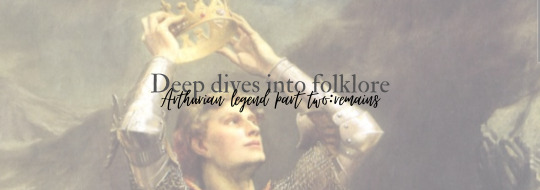
The Arthurian legends have captivated imaginations for centuries, weaving a tapestry of chivalry, romance, and heroic quests. While King Arthur himself remains a figure shrouded in myth and mystery, many of the stories associated with him are said to have their roots in the rugged landscapes of Wales. In the second part of this deep dive, we'll embark on a journey to explore modern-day locations in Wales that are believed to be the basis for some of the most enduring tales of King Arthur and his knights.
Tintagel Castle, Cornwall and Dinas Emrys, Gwynedd
Our exploration begins with Tintagel Castle in Cornwall and Dinas Emrys in Gwynedd, both of which are associated with Arthurian legends. Tintagel Castle, perched dramatically on the Cornish coast, is believed by some to be the birthplace of King Arthur. While this claim remains unverified, the castle's dramatic setting and historical significance make it a must-visit for Arthurian enthusiasts. (or at least those with the patience to walk up and down a lot of stairs, trust me, ive been there)
In contrast, Dinas Emrys, a hill fort in Snowdonia, is connected to Arthurian lore through the legend of the red and white dragons. According to the legend, the future King Vortigern sought to build a fortress at Dinas Emrys, but his efforts were thwarted by the discovery of two battling dragons—one white and one red. A young Merlin, believed to have been a wizard and advisor to King Arthur, interpreted this as a prophecy of the conflict between the Britons (represented by the red dragon) and the Saxons (represented by the white dragon).
Caerleon, Newport
Caerleon, a picturesque town near Newport, is often identified with the ancient city of Camelot. In Arthurian legends, Camelot was the legendary court of King Arthur and the Knights of the Round Table. While there is no concrete historical evidence linking Caerleon to Camelot, the town's Roman ruins, including an impressive amphitheater and fortress, add to its mystique. Visitors can explore the remains of Isca Augusta and imagine the grandeur of Arthur's court.
Arthur's Stone, Gower Peninsula
On the stunning Gower Peninsula in South Wales, you'll find Arthur's Stone, a Neolithic burial chamber also known as Maen Ceti. Legend has it that this massive stone was thrown onto the peninsula by King Arthur himself. While this may be a whimsical embellishment, the site's ancient history and striking location overlooking the landscape make it a captivating place to visit.
Llyn Llydaw, Snowdonia
Llyn Llydaw, a serene glacial lake nestled beneath the towering peaks of Snowdonia, is associated with the Lady of the Lake—a character often featured in Arthurian legends. According to the tales, it was here that the Lady of the Lake gave King Arthur the legendary sword Excalibur. While this might be more legend than history, the lake's tranquil beauty and the surrounding wilderness offer a sense of the mystical that resonates with Arthurian themes.
Glastonbury Tor, Somerset
Although not in Wales, Glastonbury Tor in Somerset, England, is closely connected to Arthurian legends and deserves a mention. The Tor is said to be the location of the mythical Avalon, where King Arthur's body was laid to rest after his death. Many believe that the Tor's enigmatic terraces and the nearby Chalice Well Gardens are steeped in the Arthurian legacy, making it a significant pilgrimage site for enthusiasts of the legends.
Conclusion
The modern-day locations in Wales, along with some neighboring areas, offer a rich tapestry of settings and landmarks that have become deeply ingrained in the Arthurian legends. While the historical accuracy of these associations may remain elusive, the charm of these places is undeniable. Whether you're a fervent Arthurian scholar or a casual admirer of legends, exploring these sites provides a tangible connection to the enduring stories of King Arthur and his knights, enriching our understanding of this captivating chapter in Welsh and British folklore.
Taglist (reply or reblog to be added):
@axl-ul @crow-flower @thoughts-fromthevoid @alderwoodbooks @harleyacoincidence @tuberosumtater @sonic-spade @theonlygardenia @holymzogynybatman @nulliel-tres
#writeblr#writers of tumblr#bookish#writing#booklr#fantasy books#creative writing#book blog#ya fantasy books#ya books#deep dives into folklore#merlin bbc#bbc merlin#folklore#books#literature#merlin#king arthur#merlin emrys#arthur pendragon#guinevere#morgana pendragon#gaius
10 notes
·
View notes
Text
Nanscough: A Gothic Scarlet Hollow AU
Nanscough (Cornish: Scarlet Valley) is a village and civil parish in Cornwall. The local tin mine, owned by the prominent Cough (pronounced ko) family, was once prosperous and drew many to the area. A few Afro-Caribbean families even settled in Nanscough a century ago and are now assimilated into local life. But the tin trade began to decline earlier in the century following a collapse in Nanscough Mines, and the town’s fortunes fell along with it. The parish is also home to the Seven Maids, local megaliths said to be a group of girls turned to stone for dancing on the Sabbath. Lately the area has been plagued by reports of creatures from Cornish lore – giants, pixies, Tommyknockers, phantom cats, and even the Devil’s Dandy Dogs. Nanscough will not give up its secrets easily….
Mr./Miss/Mx. MC Cough: MC grew up in genteel poverty with their mother, the late Vivian Cough, who fled her ancestral home under mysterious circumstances. They are visiting Nanscough for the first time in their life to attend the funeral of their aunt, Mrs. Anne Cough.
Miss Tabitha Cough: Iron-fisted manager of Nanscough Mines and mistress of Nanscough Hall. Cousin to MC.
Dustin: A badger living in a dresser in the Hall. Son to Dustin Mam. Speaks broken English with a strong Cornish accent.
Dustin Mam: Another badger living in a dresser in the Hall. Mother of Dustin. Also speaks broken English with a strong Cornish accent.
Frou-Frou: Nanscough Hall cat. Speaks with a French accent.
Miss Stella Trelawney: Former lady’s companion to Miss Cough, current lady reporter investigating stories of the Devil’s Dandy Dogs. Owner of Gretchen. Friend to Cora and Rhys.
Gretchen: Stella’s lapdog. Speaks the Queen’s English.
Miss Cora Forsyth: Afro-Caribbean shopkeeper, aspiring naturalist, and lover of Gothic tales and penny dreadfuls. Friend to Stella and Rhys. Sister of Miles and daughter of Sybil.
Mrs. Sybil Forsyth: Town midwife, herbalist, and shop owner. Mother to Cora and Miles. A fixture of Nanscough.
Master Miles Forsyth: Indifferent Afro-Caribbean youth. Lover of boy’s adventure tales and little else. Son of Sybil and brother of Cora.
Mx. Avery Bell: Afro-Caribbean barkeep at the Bell, Nanscough’s only public house. Nibling to Winifred. Liked by all, but close to no one.
Mrs. Winifred Bell: Widowed Afro-Caribbean landlady of the Bell. Aunt to Avery. Makes the best pasties. Another town fixture.
Mr. “Duke” Calloway: Local farmer. Claims to be descended from British royalty, hence the nickname. Father to Beau. Distant cousin to Julius.
Mr. Beau Calloway: Local farmer. Large adult son to Duke. Distant cousin to Julius.
Mr. Julius Tremaine: Local farmer. Scoffs at his family’s claim to royal blood. Distant cousin to Duke and Beau.
The Miners: Come from all over Cornwall and even parts beyond.
Mr. Oscar Gutierrez: British-born Spaniard schoolmaster. Father to Rosalina.
Miss Rosalina Gutierrez: British-born Spaniard girl. Daughter to Oscar. Friend to Alexis, Miles, Rebecca, and Zane.
Morsel: The Gutierrez’s cat. Speaks broken English.
Sheriff Hammet: Affable town sheriff. Suitor of the Widow Bell.
Deputy Teague: Overly-serious sheriff’s deputy. Owner of the Lord Mayor.
Deputy Penrose: Calm sheriff’s deputy. Takes ninepins far too seriously.
Jimmy: Deputy Teague’s dog. Affectionately known as the Lord Mayor. Speaks with a slight accent.
Scraps and Daisy: Local dogs and leaders of the Dog Militia. Speak with accents.
Vicar Daniel: Local vicar with sparsely attended sermons. Strange and off-putting. Husband to Mrs. Jane, father to Flora.
Mrs. Jane: Vicar Daniel’s wife, mother of Flora, keeper of sheep. Forces weekly social calls on Tabitha.
Miss Flora: Daughter of Vicar Daniel and Mrs. Jane. Claims to have befriended pixies at the Seven Maids.
Dr. Joan Kelly: One of Britain’s first female licensed doctors. Formerly of London by way of Ireland. Claims to be the widow of a sea captain who died during a transatlantic voyage. Mother to Rhys.
Mr. Rhys Kelly: “Consumptive” artist. Bought to Cornwall by his doctor mother to “recover his strength” in country air. Extremely Byronic. Son to Dr. Kelly. Friend to Stella and Cora.
The other youths: Miss Rebecca, Miss Alexis, Master Zane. Friends to Miles and Rosalina. Probably up to no good.
Mrs. Nancy: An ill-tempered and entitled miner’s wife. Mother to Miss Rebecca.
Mr. Samuel Wayne: Nanscough Hall groundskeeper, currently neglecting his duties. Probably not the host of an inhuman consciousness.
#Scarlet Hollow#Alternate Universe#Scarlet Hollow Characters#I skipped some of the animals and all of the dead people#Let me know if I missed anybody important#Gothic AU#Victorian AU
44 notes
·
View notes
Text
Things I love about the TF2 lore:
The demoman's eye socket is canonically haunted and the scream fortress events aren't one offs but actually canon. Medic has tried to replace his eye but every holloween it leaves his skull to become a monster.
William Shakesphere invented rocket jumping due to two story houses being invented but not stairs
The sniper being from new zealand was subtly hinted at from the start ("Bloody fruitshop owners" was a reference to a new zealand skit show, and the jarate promo image saying "Made in New Zealand"
Scout dies on the same exact day as the Bite of '87
Abraham Lincoln was the original pyro (Along with a bunch of other historical/folklore characters being the original mercs)
Soldier's flanderization from "Insane military buff" to "Insane military buffoon" is due to him contracting lead poisoning from Teufort's water supply
2fort is in Teufort, which was originally named "Hugginsville" after its founder who was mauled to death by bears but then renamed "Two Farts" by a roving gang of schoolyard bullies which was then changed to "Teufort" becuase they were scared of the bullies returning
Spy keeps a full meal of cornish game hen in secret compartments in his teeth
Soldier killed Tom Jones who was then killed again in Heaven
Upon losing their job, The Pyro became CEO of a successful Fortune 500 company despite not being able to understand a word of anything anyone says around them
Eyelander is 100% haunted with a spirit who demands heads but is just sorta bros with Demoman
Saxton Hale invented jarate by kicking over a chair
Saxton's Hale's desk is a massive griddle for cooking steak
Yetis used to exist but they've been hunted to extinction by Saxton Hale
9 notes
·
View notes
Text
Cross Border Cups With Scotland
How about Saudi Arabia fund a cross border club trophy with teams from Saudi Arabia, Scotland, the Netherlands, Poland, Switzerland, Denmark, Belgium, France, North America, Africa and other European nations? Saudi Arabia has wealth, but Scotland has intense passionate supporters. Clubs like Glasgow Celtic, Aberdeen, Glasgow Rangers, Motherwell, Heart of Midlothian, Hibernian, Dundee, and Dundee United could bring passionate games and lore to Saudi soccer.How about cross border cups for Scottish football. I say a good way for Scottish football to improve is to have cross border trophies on top of domestic and European football.There are an entire host of ideas that could happen. Bring back the Anglo Scottish Cup.Change the Scottish Premiership to a 16 team 30 game league. Then have extra cross border cups.Ideas could include a North Atlantic League Cup. With the top four to 8 SPFL clubs playing a group stage trophy with teams from Europe, Asia, or Africa, or North America, or Saudi Arabia.The Scottish allow Welsh and Northern Ireland club sides in the Scottish Challenge Cup.The Scottish and Welsh Rugby clubs travel to places like South Africa, and Italy. And UEFA soccer has seen Scottish sides travel to Central Asia. So football clubs could travel 5 or 8 times a year to the USA, or Africa. In UEFA trophies Scottish and Welsh sides have been to Central Asia.Other ideas could include having all Scottish Premiership sides not in Europe, plus selected Welsh Cymru Premier club sides, and perhaps Belgian, and North West French sides in the Football League Trophy. There could easily be 16 teams added to the EFL Trophy with a little reorganisation of the trophy to add the new sides.Perhaps all Scots Championsip sides, Welsh Cymru Premier sides, and some North Western French sides in the non-league FA Trophy.
Or a Celtic Nations Club Cup of Scottish, Welsh, Irish, Ulster, Cornish, Cumbria, Brittany, Isle of Man and Yorkshire club sides.Perhaps leading Scottish, Irish, French, Dutch, Belgian or German sides invited as guests into the Engliah FA Cup, or English League Cup.I do not support merging the British leagues, as people would wrongly think Scotland was part of England. And all the Scottish trophies in history would be relegated to the status of lower tier trophies. While all the English trophies would be seen as forerunners of the British trophies. So Scottish clubs would be seen to be reset as having won ZERO trophies. Also 30 trips into England a year might be too much bit 5 to 8 times a year would keep it a novelty and highlight of the season.We need Pan-Great Britain Cups on top of domestic and European football.If we had a British League a club like Dundee could make 25 trips year of up to 800 miles. That would be too tough. It has to be at a manageable number of games.
2 notes
·
View notes